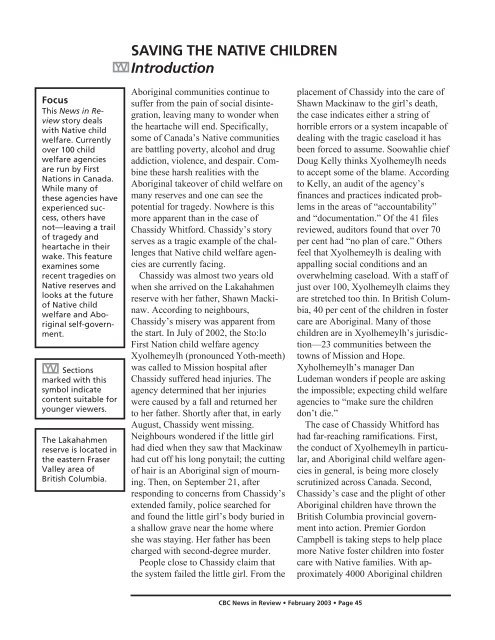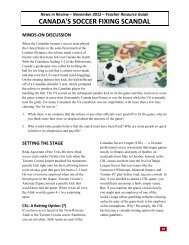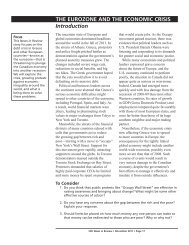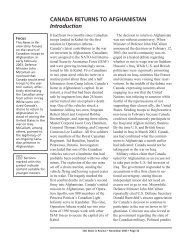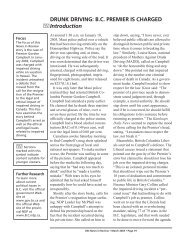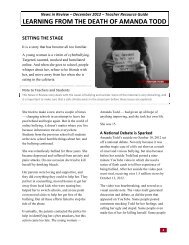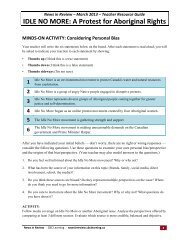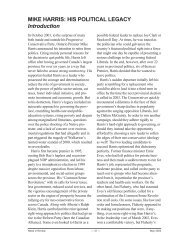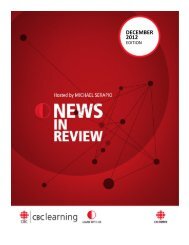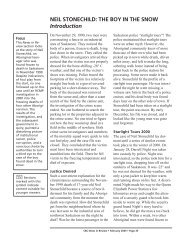View Resource Guide content for this story. - News in review
View Resource Guide content for this story. - News in review
View Resource Guide content for this story. - News in review
Create successful ePaper yourself
Turn your PDF publications into a flip-book with our unique Google optimized e-Paper software.
Focus<br />
This <strong>News</strong> <strong>in</strong> Review<br />
<strong>story</strong> deals<br />
with Native child<br />
welfare. Currently<br />
over 100 child<br />
welfare agencies<br />
are run by First<br />
Nations <strong>in</strong> Canada.<br />
While many of<br />
these agencies have<br />
experienced success,<br />
others have<br />
not—leav<strong>in</strong>g a trail<br />
of tragedy and<br />
heartache <strong>in</strong> their<br />
wake. This feature<br />
exam<strong>in</strong>es some<br />
recent tragedies on<br />
Native reserves and<br />
looks at the future<br />
of Native child<br />
welfare and Aborig<strong>in</strong>alself-government.<br />
YV<br />
Sections<br />
marked with <strong>this</strong><br />
symbol <strong>in</strong>dicate<br />
<strong>content</strong> suitable <strong>for</strong><br />
younger viewers.<br />
The Lakahahmen<br />
reserve is located <strong>in</strong><br />
the eastern Fraser<br />
Valley area of<br />
British Columbia.<br />
YV<br />
SAVING THE NATIVE CHILDREN<br />
Introduction<br />
Aborig<strong>in</strong>al communities cont<strong>in</strong>ue to<br />
suffer from the pa<strong>in</strong> of social dis<strong>in</strong>tegration,<br />
leav<strong>in</strong>g many to wonder when<br />
the heartache will end. Specifically,<br />
some of Canada’s Native communities<br />
are battl<strong>in</strong>g poverty, alcohol and drug<br />
addiction, violence, and despair. Comb<strong>in</strong>e<br />
these harsh realities with the<br />
Aborig<strong>in</strong>al takeover of child welfare on<br />
many reserves and one can see the<br />
potential <strong>for</strong> tragedy. Nowhere is <strong>this</strong><br />
more apparent than <strong>in</strong> the case of<br />
Chassidy Whit<strong>for</strong>d. Chassidy’s <strong>story</strong><br />
serves as a tragic example of the challenges<br />
that Native child welfare agencies<br />
are currently fac<strong>in</strong>g.<br />
Chassidy was almost two years old<br />
when she arrived on the Lakahahmen<br />
reserve with her father, Shawn Mack<strong>in</strong>aw.<br />
Accord<strong>in</strong>g to neighbours,<br />
Chassidy’s misery was apparent from<br />
the start. In July of 2002, the Sto:lo<br />
First Nation child welfare agency<br />
Xyolhemeylh (pronounced Yoth-meeth)<br />
was called to Mission hospital after<br />
Chassidy suffered head <strong>in</strong>juries. The<br />
agency determ<strong>in</strong>ed that her <strong>in</strong>juries<br />
were caused by a fall and returned her<br />
to her father. Shortly after that, <strong>in</strong> early<br />
August, Chassidy went miss<strong>in</strong>g.<br />
Neighbours wondered if the little girl<br />
had died when they saw that Mack<strong>in</strong>aw<br />
had cut off his long ponytail; the cutt<strong>in</strong>g<br />
of hair is an Aborig<strong>in</strong>al sign of mourn<strong>in</strong>g.<br />
Then, on September 21, after<br />
respond<strong>in</strong>g to concerns from Chassidy’s<br />
extended family, police searched <strong>for</strong><br />
and found the little girl’s body buried <strong>in</strong><br />
a shallow grave near the home where<br />
she was stay<strong>in</strong>g. Her father has been<br />
charged with second-degree murder.<br />
People close to Chassidy claim that<br />
the system failed the little girl. From the<br />
CBC <strong>News</strong> <strong>in</strong> Review • February 2003 • Page 45<br />
placement of Chassidy <strong>in</strong>to the care of<br />
Shawn Mack<strong>in</strong>aw to the girl’s death,<br />
the case <strong>in</strong>dicates either a str<strong>in</strong>g of<br />
horrible errors or a system <strong>in</strong>capable of<br />
deal<strong>in</strong>g with the tragic caseload it has<br />
been <strong>for</strong>ced to assume. Soowahlie chief<br />
Doug Kelly th<strong>in</strong>ks Xyolhemeylh needs<br />
to accept some of the blame. Accord<strong>in</strong>g<br />
to Kelly, an audit of the agency’s<br />
f<strong>in</strong>ances and practices <strong>in</strong>dicated problems<br />
<strong>in</strong> the areas of “accountability”<br />
and “documentation.” Of the 41 files<br />
<strong>review</strong>ed, auditors found that over 70<br />
per cent had “no plan of care.” Others<br />
feel that Xyolhemeylh is deal<strong>in</strong>g with<br />
appall<strong>in</strong>g social conditions and an<br />
overwhelm<strong>in</strong>g caseload. With a staff of<br />
just over 100, Xyolhemeylh claims they<br />
are stretched too th<strong>in</strong>. In British Columbia,<br />
40 per cent of the children <strong>in</strong> foster<br />
care are Aborig<strong>in</strong>al. Many of those<br />
children are <strong>in</strong> Xyolhemeylh’s jurisdiction—23<br />
communities between the<br />
towns of Mission and Hope.<br />
Xyholhemeylh’s manager Dan<br />
Ludeman wonders if people are ask<strong>in</strong>g<br />
the impossible; expect<strong>in</strong>g child welfare<br />
agencies to “make sure the children<br />
don’t die.”<br />
The case of Chassidy Whit<strong>for</strong>d has<br />
had far-reach<strong>in</strong>g ramifications. First,<br />
the conduct of Xyolhemeylh <strong>in</strong> particular,<br />
and Aborig<strong>in</strong>al child welfare agencies<br />
<strong>in</strong> general, is be<strong>in</strong>g more closely<br />
scrut<strong>in</strong>ized across Canada. Second,<br />
Chassidy’s case and the plight of other<br />
Aborig<strong>in</strong>al children have thrown the<br />
British Columbia prov<strong>in</strong>cial government<br />
<strong>in</strong>to action. Premier Gordon<br />
Campbell is tak<strong>in</strong>g steps to help place<br />
more Native foster children <strong>in</strong>to foster<br />
care with Native families. With approximately<br />
4000 Aborig<strong>in</strong>al children
<strong>in</strong> foster care, many of whom are liv<strong>in</strong>g<br />
<strong>in</strong> non-Native care, the Premier hopes<br />
to provide the educational resources and<br />
f<strong>in</strong>ancial support to transfer as many<br />
Native foster children as possible <strong>in</strong>to<br />
care with their fellow Natives. Critics of<br />
Campbell’s government claim the<br />
Premier’s plan is contradictory. While<br />
simultaneously plann<strong>in</strong>g to transfer all<br />
To Consider<br />
1. What elements of social dis<strong>in</strong>tegration can be found on some First<br />
Nation reserves?<br />
2. What evidence do some people po<strong>in</strong>t to when suggest<strong>in</strong>g that<br />
Xyolhemeylh failed Chassidy Whit<strong>for</strong>d? Is it fair to blame Xyolhemeylh<br />
<strong>for</strong> the little girl’s death? Expla<strong>in</strong>.<br />
3. Doug Kelly was one of the founders of Xyolhemeylh. He was <strong>for</strong>ced to<br />
resign after a 1995 prov<strong>in</strong>cial <strong>review</strong> found the follow<strong>in</strong>g:<br />
• foster homes were opened without home study or a crim<strong>in</strong>al record<br />
check<br />
• a misuse of confidential <strong>in</strong><strong>for</strong>mation<br />
• a diversion of funds<br />
• a high turnover of staff<br />
• an explosive growth <strong>in</strong> apprehensions (tak<strong>in</strong>g children <strong>in</strong>to custody)<br />
The report eventually concluded that Xyolhemeylh was “divorced from<br />
the community it serves.”<br />
CBC <strong>News</strong> <strong>in</strong> Review • February 2003 • Page 46<br />
Aborig<strong>in</strong>al child welfare to First Nations<br />
by April 2003, he is also plann<strong>in</strong>g<br />
to cut the child welfare budget by 30<br />
per cent. With <strong>in</strong>adequate f<strong>in</strong>ancial<br />
back<strong>in</strong>g, the plan may be doomed <strong>for</strong><br />
failure, and the prospect of more children<br />
fall<strong>in</strong>g through the cracks is a very<br />
real possibility.
a. Which of the prov<strong>in</strong>cial <strong>review</strong> items listed do you th<strong>in</strong>k is most<br />
detrimental to the welfare of children? Expla<strong>in</strong>.<br />
b. Did Doug Kelly do the right th<strong>in</strong>g by resign<strong>in</strong>g after the release of<br />
the report? Would he have been capable of cont<strong>in</strong>u<strong>in</strong>g as manager of<br />
Xyolhemeylh based on the <strong>in</strong><strong>for</strong>mation listed <strong>in</strong> the report?<br />
4. Is Dan Ludeman right when he says that people are expect<strong>in</strong>g child<br />
welfare to “make sure the children don’t die”? Is <strong>this</strong> a realistic expectation?<br />
Expla<strong>in</strong> your answer.<br />
CBC <strong>News</strong> <strong>in</strong> Review • February 2003 • Page 47
After watch<strong>in</strong>g <strong>this</strong><br />
video, carefully<br />
answer the questions<br />
on <strong>this</strong> page.<br />
YV<br />
SAVING THE NATIVE CHILDREN<br />
Video Review<br />
1. Who was Chassidy Whit<strong>for</strong>d?<br />
2. What happened on September 21 that changed the lives of Chassidy’s<br />
mother and grandfather?<br />
3. Who is Dan Ludeman? What is his job?<br />
_<br />
4. What was the goal of the child welfare agency known as Xyolhemeylh?<br />
5. Who was Baby Andy? What happened to him?<br />
_<br />
6. How many children died on the Samson Cree reserve between August<br />
1999 and April 2002? _________<br />
7. What was the government’s answer to the ills fac<strong>in</strong>g Native families <strong>in</strong><br />
the 1960s?<br />
8. What does the word Xyolhemeylh (Yoth-meeth) describe?<br />
9. What were some of the early signs that Xyolhemeylh was <strong>in</strong> trouble?<br />
10. What steps has the community taken to get the band elders <strong>in</strong>volved<br />
<strong>in</strong> child welfare?<br />
11. What does British Columbia Premier Gordon Campbell plan to do to<br />
improve Native child welfare?<br />
12. By how much is the British Columbia child welfare budget scheduled<br />
to be cut? ____%<br />
13. When does Premier Gordon Campbell plan to delegate child welfare<br />
to all First Nations? ________________<br />
14. Do you th<strong>in</strong>k discuss<strong>in</strong>g Chassidy <strong>in</strong> the Sto:lo way, through talk<strong>in</strong>g<br />
circles, will help Xyolhemeylh staff come to terms with her death? Why?<br />
15. What is Dan Ludeman do<strong>in</strong>g now?<br />
CBC <strong>News</strong> <strong>in</strong> Review • February 2003 • Page 48<br />
_<br />
_
Did you know . . .<br />
Canada’s Aborig<strong>in</strong>al<br />
community is<br />
grow<strong>in</strong>g faster<br />
than the non-<br />
Aborig<strong>in</strong>al community?<br />
From 1996 to<br />
2001, the Aborig<strong>in</strong>al<br />
population<br />
boomed by more<br />
than 22% while the<br />
non-Aborig<strong>in</strong>al<br />
population <strong>in</strong>creased<br />
by only<br />
3.4%.<br />
YV<br />
SAVING THE NATIVE CHILDREN<br />
Death on the Reserve: The Tragedy<br />
The death of Chassidy Whit<strong>for</strong>d served<br />
as a pa<strong>in</strong>ful rem<strong>in</strong>der of the tragedies<br />
that surfaced near Hobbema, Alberta,<br />
on the Samson Cree Nation reserve.<br />
Between August 1999 and April 2002,<br />
seven children—all under the care of<br />
the Samson Cree’s Kasohkowew Child<br />
Wellness Society—died under what can<br />
only be described as questionable<br />
circumstances. Their heartbreak<strong>in</strong>g<br />
stories are listed below.<br />
August 11, 1999 — Korvette Crier, 2,<br />
died after be<strong>in</strong>g assaulted by her foster<br />
mother, Deborah Kambietz, who lost<br />
her temper while try<strong>in</strong>g to help the little<br />
girl put on her shoes. Korvette died the<br />
day after the assault due to severe head<br />
<strong>in</strong>juries. Korvette was placed <strong>in</strong> foster<br />
care by band child welfare workers.<br />
They chose the home of Deborah<br />
Kambietz, a woman who was runn<strong>in</strong>g<br />
an unlicensed foster home. Kambietz<br />
eventually pleaded guilty to manslaughter<br />
charges and was sentenced to two<br />
years <strong>in</strong> jail followed by three years<br />
probation.<br />
September 13, 1999 — Shayleen<br />
Lighten<strong>in</strong>g, 3, died due to <strong>in</strong>juries<br />
suffered after a house fire at her home<br />
three days earlier. Shayleen woke her<br />
father, Perry Twoyoungmen, to warn<br />
him of the blaze. He jumped out the<br />
w<strong>in</strong>dow to safety, leav<strong>in</strong>g Shayleen and<br />
her sister beh<strong>in</strong>d. Twoyoungmen later<br />
pleaded guilty to fail<strong>in</strong>g to provide the<br />
necessities of life and was given a<br />
conditional six-month sentence and one<br />
year of probation. Investigators eventually<br />
discovered that child welfare<br />
workers failed to apprehend Shayleen<br />
despite Twoyoungmen’s severe dr<strong>in</strong>k-<br />
CBC <strong>News</strong> <strong>in</strong> Review • February 2003 • Page 49<br />
<strong>in</strong>g problem, the fact that the girl’s<br />
mother was <strong>in</strong> jail, and that another fire,<br />
six weeks earlier, had destroyed the<br />
trailer where Twoyoungmen and his<br />
daughters were liv<strong>in</strong>g.<br />
December 19, 2000 — Lonnie Thom,<br />
only eight weeks old, died due to an<br />
overdose of cough syrup.<br />
January 17, 2001 — Kristen Johnson,<br />
7, died due to <strong>in</strong>juries suffered <strong>in</strong> a<br />
house fire. Kristen’s family had been<br />
<strong>in</strong>vestigated by child welfare workers<br />
five times be<strong>for</strong>e her death. No file was<br />
ever opened on Kristen.<br />
March 10, 2001 — Helen Rose Ra<strong>in</strong>,<br />
15, a young woman who was a ward of<br />
the prov<strong>in</strong>ce under the parental control<br />
of the Kasohkowew Child Wellness<br />
Society, committed suicide. At the time<br />
of her death, child welfare workers had<br />
not spoken with Helen <strong>for</strong> over a month<br />
and did not know where she was liv<strong>in</strong>g.<br />
July 19, 2001 — Aaron Bull, 1, choked<br />
to death on a balloon at a birthday<br />
party. Aaron was known to<br />
Kasohkowew based on an earlier <strong>in</strong>vestigation<br />
of the boy’s mother. She was<br />
fac<strong>in</strong>g a jail sentence and they needed<br />
to f<strong>in</strong>d someone to take care of him.<br />
April 25, 2002 — Jarius Cabry, a baby<br />
of 10 months, drowned <strong>in</strong> the bathtub of<br />
his foster home.<br />
Violence, neglect, and ignorance<br />
came together <strong>in</strong> Hobbema over a 32month<br />
period. This tragic comb<strong>in</strong>ation<br />
led to the deaths of seven children.
Samson Cree<br />
Nation<br />
Population: 4800<br />
Children <strong>in</strong> protective<br />
services: 331<br />
Children <strong>in</strong> foster<br />
care: 274<br />
Children under the<br />
supervision of child<br />
welfare officials: 57<br />
Activity<br />
Work with a partner to create a memorial booklet <strong>for</strong> the seven children.<br />
On each page be sure to <strong>in</strong>clude the name of the child, the date that they<br />
died, the age of the child, and an Aborig<strong>in</strong>al symbol like the eagle’s feather,<br />
the tree of peace, or a totem.<br />
Death on the Reserve: The<br />
Aftermath<br />
The day after the death of Jarius Cabry,<br />
the M<strong>in</strong>ister of Children’s Services <strong>for</strong><br />
Alberta, Iris Evans, took away<br />
Kasohkowew’s authority to manage<br />
child welfare <strong>in</strong> the Aborig<strong>in</strong>al communities<br />
that it served. The Samson Cree<br />
Nation responded by refus<strong>in</strong>g to allow<br />
prov<strong>in</strong>cial workers to exam<strong>in</strong>e their<br />
case files. Amid the grief brought on by<br />
the deaths of the children, and the<br />
power struggle between the band and<br />
the prov<strong>in</strong>ce, the search <strong>for</strong> answers<br />
began. Soon it became clear that the<br />
problem rested <strong>in</strong> three areas. These<br />
<strong>in</strong>cluded poor parent<strong>in</strong>g, an overworked<br />
and overwhelmed child welfare<br />
agency, and a lack of co-ord<strong>in</strong>ation<br />
between government, both federal and<br />
prov<strong>in</strong>cial, and the Samson Cree Nation.<br />
The <strong>in</strong>ability of a parent to provide<br />
care <strong>for</strong> their child defies rational<br />
explanation. One child protection<br />
worker from Kasohkowew reported<br />
mak<strong>in</strong>g 11 apprehensions <strong>in</strong> one day.<br />
The level of neglect of some children <strong>in</strong><br />
the Samson Cree Nation can only be<br />
described as shock<strong>in</strong>g. Accord<strong>in</strong>g to<br />
some, one of the ma<strong>in</strong> problems has to<br />
do with the parents’ lack of basic<br />
parent<strong>in</strong>g skills. This problem could be<br />
dealt with by direct<strong>in</strong>g fund<strong>in</strong>g <strong>in</strong>to<br />
education and assistance programs <strong>for</strong><br />
parents. Currently, the federal government<br />
gives the Samson Cree Nation<br />
$12-million a year to run its child<br />
welfare system. That money has been<br />
designated <strong>for</strong> “child protection” pro-<br />
CBC <strong>News</strong> <strong>in</strong> Review • February 2003 • Page 50<br />
grams like foster care. Some believe<br />
that the time has come <strong>for</strong> Ottawa to<br />
allow Aborig<strong>in</strong>al child welfare agencies<br />
to direct some of that money toward<br />
early <strong>in</strong>tervention and education programs<br />
<strong>for</strong> families and parents.<br />
The second problem revealed by the<br />
crisis on the reserve had to do with the<br />
Kasohkowew Child Wellness Society<br />
itself. Shortly after the deaths of<br />
Korvette Crier and Shayleen Lighten<strong>in</strong>g,<br />
a department <strong>review</strong> <strong>in</strong>dicated that<br />
staff were cop<strong>in</strong>g with unmanageable<br />
caseloads. This led to extensive overtime,<br />
a high staff turnover and burnout,<br />
and an <strong>in</strong>ability to keep up with paper<br />
work.<br />
Kasohkowew staff felt they were<br />
be<strong>in</strong>g unfairly targeted <strong>for</strong> the deaths of<br />
the children. They claimed that a high<br />
percentage of the population they<br />
served abused alcohol and drugs, suffered<br />
<strong>in</strong> poverty, and were poorly<br />
educated. Violence and neglect were<br />
common on the reserve. Despite <strong>this</strong>,<br />
Kasohkowew staff were eventually<br />
reprimanded <strong>for</strong> their conduct. After the<br />
standoff over the case files, a compromise<br />
with the government was reached.<br />
A jo<strong>in</strong>t prov<strong>in</strong>cial and band <strong>review</strong> of<br />
167 files revealed three areas <strong>in</strong> need of<br />
immediate improvement:<br />
1. supervis<strong>in</strong>g of suicidal children<br />
2. monitor<strong>in</strong>g of foster homes<br />
3. plann<strong>in</strong>g <strong>for</strong> the future of children<br />
Clearly Kasohkowew staff were<br />
deal<strong>in</strong>g with unique circumstances. The<br />
agency felt they needed more resources<br />
to do their job properly.
Def<strong>in</strong>ition<br />
An ethnohistorian<br />
is a historian who<br />
studies the hi<strong>story</strong><br />
of races and cultures.<br />
So, from where would these resources<br />
come? The current adm<strong>in</strong>istrative<br />
model has the federal government<br />
fund<strong>in</strong>g child welfare, the prov<strong>in</strong>cial<br />
government supervis<strong>in</strong>g programs, and<br />
the Aborig<strong>in</strong>al agencies deliver<strong>in</strong>g<br />
programs. The Samson Cree Nation<br />
claims that more fund<strong>in</strong>g would help<br />
them to staff and deliver programs more<br />
effectively. Others wonder why the<br />
Samson Cree, a First Nation that earns<br />
CBC <strong>News</strong> <strong>in</strong> Review • February 2003 • Page 51<br />
oil and gas royalties beyond the money<br />
it receives from the federal government,<br />
have not directed some of their<br />
own resources toward child welfare.<br />
James Dempsey, an ethnohistorian<br />
from the University of Alberta’s<br />
school of Native studies asks, “Why do<br />
we have a band that, on the books, is<br />
mak<strong>in</strong>g lots of money but, when you<br />
look at it, is not any different from<br />
(poorer bands) <strong>in</strong> Alberta?”<br />
Questions<br />
1. What were the three problem areas said to have contributed to the<br />
deaths on the reserve?<br />
i) _______________________________________________________________<br />
ii) ______________________________________________________________<br />
iii) ______________________________________________________________<br />
2. Do you th<strong>in</strong>k the fund<strong>in</strong>g <strong>for</strong> child welfare should be opened up to<br />
<strong>in</strong>clude early <strong>in</strong>tervention and education programs? Would these types<br />
of programs work? Expla<strong>in</strong> clearly.<br />
3. What do you th<strong>in</strong>k was the lead<strong>in</strong>g factor contribut<strong>in</strong>g to the deaths<br />
on the reserve? Why?
Review <strong>this</strong> statistical<br />
<strong>in</strong><strong>for</strong>mation<br />
with a partner<br />
be<strong>for</strong>e complet<strong>in</strong>g<br />
the activity that<br />
follows the statistics<br />
themselves.<br />
Further Research<br />
Some sites that<br />
provide useful<br />
<strong>in</strong><strong>for</strong>mation about<br />
Canada’s Aborig<strong>in</strong>al<br />
Peoples <strong>in</strong>clude<br />
the follow<strong>in</strong>g:<br />
Indian and Northern<br />
Affairs Canada<br />
at www.a<strong>in</strong>c<strong>in</strong>ac.gc.ca<br />
and<br />
Statistics Canada at<br />
www.statscan.ca.<br />
YV<br />
SAVING THE NATIVE CHILDREN<br />
<strong>News</strong> Data — Statistical Analysis<br />
• There are 1.4 million Aborig<strong>in</strong>al<br />
Canadians.^<br />
• Ottawa spends $7-billion dollars on<br />
Aborig<strong>in</strong>al Canadians, $5-billion of<br />
which is directly transferred to First<br />
Nation reserves. That amounts to<br />
about $40 000 per Native household<br />
or $15 000 per Aborig<strong>in</strong>al Canadian.^<br />
• The unemployment rate on Canadian<br />
reserves is 29%, almost four times the<br />
national average. <br />
• The life expectancy among Aborig<strong>in</strong>al<br />
people is six years shorter than the<br />
Canadian average.*<br />
• Suicide rates among Aborig<strong>in</strong>al<br />
people are five to eight times higher<br />
than the national average.*<br />
• Across Canada, six per cent of Aborig<strong>in</strong>al<br />
children on Canadian reserves<br />
were <strong>in</strong> government care (foster<br />
homes, group homes, or <strong>in</strong>stitutional<br />
care) <strong>in</strong> 2000-2001.*<br />
• In British Columbia, eight per cent of<br />
children are Native. Forty per cent of<br />
those children are <strong>in</strong> foster care. In<br />
northern B.C., that number jumps to<br />
70 per cent. §<br />
CBC <strong>News</strong> <strong>in</strong> Review • February 2003 • Page 52<br />
• Aborig<strong>in</strong>al children are 25 times<br />
more likely to suffer fetal alcohol<br />
syndrome than the world average. ∞<br />
• Tuberculosis rates among Native<br />
people are more than 10 times higher<br />
than the national average. ∞<br />
• About one <strong>in</strong> eight Aborig<strong>in</strong>al Native<br />
communities are threatened by<br />
unsafe water. ∞<br />
• Diabetes rates <strong>for</strong> Aborig<strong>in</strong>als are<br />
two to three times higher than <strong>for</strong><br />
non-Aborig<strong>in</strong>als. ∞<br />
• Aborig<strong>in</strong>als over the age of 15 are<br />
about twice as likely to smoke. ∞<br />
^ Source: Calgary Herald, May 24, 2002<br />
* Source: Indian and Northern Affairs<br />
Canada<br />
Source: Indian and Northern Affairs<br />
Canada and Statistics Canada<br />
∞ Source: Health Canada and the<br />
Assembly of First Nations (National<br />
Post, February 28, 2001)<br />
§ Editorial, Vancouver Sun, September<br />
13, 2002<br />
Activity<br />
1. Make a four-column organizer <strong>in</strong> you notebook. Organize the statistical<br />
<strong>in</strong><strong>for</strong>mation under the follow<strong>in</strong>g head<strong>in</strong>gs:<br />
General In<strong>for</strong>mation / Health / Child Welfare / Social Conditions<br />
Note: Feel free to enter <strong>in</strong><strong>for</strong>mation under more than one head<strong>in</strong>g.<br />
2. a) Re-evaluate the statistical <strong>in</strong><strong>for</strong>mation listed above and rank the<br />
<strong>in</strong><strong>for</strong>mation from most important to least important.<br />
Most Important Least Important<br />
1 2 3 4 5 6 7 8 9 10<br />
b) Expla<strong>in</strong> why you selected one item as the most important.
YV<br />
SAVING THE NATIVE CHILDREN<br />
There Is Hope<br />
In spite of the severity of the challenges<br />
fac<strong>in</strong>g many Aborig<strong>in</strong>al communities,<br />
there is much evidence of success and<br />
progress. Some Aborig<strong>in</strong>al communities<br />
have taken matters <strong>in</strong>to their own<br />
hands by fight<strong>in</strong>g social dis<strong>in</strong>tegration<br />
with community activism.<br />
Pikangikum, a First Nation located on<br />
the Manitoba-Ontario border, was given<br />
the title “Suicide Capital of Canada” <strong>in</strong><br />
2001 when seven young people killed<br />
themselves <strong>in</strong> the first half of the year<br />
alone. That put Pikangikum’s suicide<br />
rate at 38 times the national average.<br />
Once the nation’s attention shifted to<br />
the small town it became clear that<br />
many of the communities’ young<br />
people had developed a serious substance<br />
abuse problem. <strong>News</strong> stories<br />
reported that young people were sniff<strong>in</strong>g<br />
gasol<strong>in</strong>e <strong>in</strong> an area of town referred<br />
to as “Gasol<strong>in</strong>e Alley.” The plight of<br />
the young was mirrored by widespread<br />
alcoholism among the adult population.<br />
It appeared that Pikangikum had slipped<br />
<strong>in</strong>to despair. The mood of the community<br />
was summarized <strong>in</strong> bold red spray<br />
pa<strong>in</strong>t on the side of an oil tank that read<br />
“Welcome to Hell.”<br />
The people of Pikangikum responded<br />
to the crisis <strong>in</strong> the summer of 2001.<br />
Alarmed at the suicide rate <strong>in</strong> their<br />
community, 100 residents marched 600<br />
kilometres to W<strong>in</strong>nipeg to raise aware-<br />
CBC <strong>News</strong> <strong>in</strong> Review • February 2003 • Page 53<br />
ness of the crippl<strong>in</strong>g social problems <strong>in</strong><br />
their community. The citizens who<br />
participated <strong>in</strong> the march on W<strong>in</strong>nipeg<br />
made it clear that their isolation needed<br />
to end. S<strong>in</strong>ce Pikangikum could only be<br />
accessed by plane, community leaders<br />
asked politicians <strong>for</strong> new roads and<br />
<strong>in</strong>frastructure to unite them with other<br />
towns. Initial steps have been taken to<br />
beg<strong>in</strong> to build these roads.<br />
The march on W<strong>in</strong>nipeg was just part<br />
of the community rebuild<strong>in</strong>g ef<strong>for</strong>t.<br />
With over half of the 2001 residents of<br />
Pikangikum under the age of 21, community<br />
leaders started design<strong>in</strong>g programs<br />
to combat the hopelessness of the<br />
preced<strong>in</strong>g year. People began to organize<br />
fish<strong>in</strong>g derbies and floor hockey<br />
tournaments. They also started a Girl<br />
Power program. Forty-five girls jo<strong>in</strong>ed<br />
the program, meet<strong>in</strong>g four times a week<br />
to play broomball, floor hockey, and<br />
soccer. In the summer of 2002, 600<br />
members of the Pikangikum community<br />
attended “Family Day,” shar<strong>in</strong>g a festive<br />
meal after repa<strong>in</strong>t<strong>in</strong>g the local school.<br />
Although the problems <strong>in</strong><br />
Pikangikum have not disappeared, the<br />
community has brought hope to a place<br />
once mired <strong>in</strong> despair. They have<br />
demonstrated that the best way to<br />
address the needs of its people is to<br />
build strong, cohesive, and united<br />
community bonds.<br />
Respond<strong>in</strong>g<br />
1. Why do you th<strong>in</strong>k someone spray pa<strong>in</strong>ted the message “Welcome to<br />
Hell” on the side of an old oil tank <strong>in</strong> the town of Pikangikum?<br />
2. How have the ef<strong>for</strong>ts of community leaders contributed to improved<br />
child welfare <strong>in</strong> Pikangikum?<br />
3. Make a list of the steps taken by the community to improve life <strong>in</strong><br />
Pikangikum.
“Accountability,<br />
transparency,<br />
democracy and the<br />
rule of law: These<br />
are the pillars that<br />
hold up civil society;<br />
these are the<br />
standards that<br />
citizens expect of<br />
government.” —<br />
Peter Hadekel, The<br />
Montreal Gazette,<br />
June 20, 2002<br />
SAVING THE NATIVE CHILDREN<br />
The First Nations Governance Act<br />
The plight of Aborig<strong>in</strong>al children has<br />
struck the very heart of the Native selfgovernment<br />
movement. While recent<br />
trends have seen federal and prov<strong>in</strong>cial<br />
governments recognize the Aborig<strong>in</strong>al<br />
right to self-government, the poor track<br />
record of some bands has h<strong>in</strong>dered <strong>this</strong><br />
process. There are several areas of<br />
concern:<br />
Social Conditions<br />
The failure of some Aborig<strong>in</strong>al child<br />
welfare agencies to protect the <strong>in</strong>terests<br />
of children is one area of concern.<br />
Many see the failures <strong>in</strong> child welfare<br />
as symptomatic of the brutal social<br />
conditions on some reserves.<br />
Democracy<br />
Another area of concern is the election<br />
of chiefs and councillors on reserves. In<br />
some bands, voters feel they have<br />
limited say <strong>in</strong> elections. Some worry<br />
about an apparent culture of “vote<br />
buy<strong>in</strong>g” by people vy<strong>in</strong>g <strong>for</strong> seats on<br />
band executives.<br />
F<strong>in</strong>ances<br />
F<strong>in</strong>ancial mismanagement is also a<br />
major concern. Two cases illustrate <strong>this</strong><br />
po<strong>in</strong>t: Chief Robert Horseman of Horse<br />
Lake First Nation <strong>in</strong> Alberta was paid<br />
$439 425 <strong>in</strong> 2001, while many of his<br />
band lived <strong>in</strong> poverty. Workers at the<br />
Virg<strong>in</strong>ia Fonta<strong>in</strong>e Native treatment<br />
centre <strong>in</strong> Manitoba were sent on an<br />
expensive Caribbean cruise <strong>in</strong> order to<br />
help them avoid staff burnout.<br />
These concerns have given the federal<br />
government <strong>in</strong>creased resolve to<br />
overhaul the Indian Act of 1876. M<strong>in</strong>ister<br />
of Indian and Northern Affairs<br />
CBC <strong>News</strong> <strong>in</strong> Review • February 2003 • Page 54<br />
Robert Nault recently <strong>in</strong>troduced the<br />
First Nations Governance Act (FNGA).<br />
The goal of the FNGA is to br<strong>in</strong>g<br />
<strong>in</strong>creased transparency, greater accountability,<br />
and improved democratic<br />
processes to Aborig<strong>in</strong>al communities.<br />
Accord<strong>in</strong>g to the federal government,<br />
the FNGA is long overdue. First Nations<br />
need legislative protection more<br />
suited to the 21st century than the 19th<br />
century statutes of the Indian Act. On a<br />
practical level, the government believes<br />
that the FNGA will improve the lives of<br />
average Aborig<strong>in</strong>al Canadians. New<br />
rules regard<strong>in</strong>g the election of First<br />
Nations leaders will create more democracy<br />
with<strong>in</strong> bands. The act will also<br />
make band f<strong>in</strong>ances a matter of public<br />
record. Accord<strong>in</strong>g to a summary of the<br />
FNGA, Native bands will need to<br />
follow standard account<strong>in</strong>g procedures<br />
and make their f<strong>in</strong>ancial statements<br />
publicly available, provid<strong>in</strong>g a copy of<br />
the statements <strong>for</strong> a “reasonable fee” to<br />
anyone who is <strong>in</strong>terested. Accord<strong>in</strong>g to<br />
Robert Nault, the M<strong>in</strong>istry of Indian<br />
and Northern Affairs consulted 10 000<br />
grassroots Natives be<strong>for</strong>e draft<strong>in</strong>g the<br />
legislation.<br />
The Assembly of First Nations (AFN)<br />
has vigorously opposed the FNGA.<br />
They po<strong>in</strong>t to the federal government’s<br />
poor track record <strong>in</strong> the area of Native<br />
affairs. For the longest time, the<br />
government’s policy was “assimilation”<br />
of Natives <strong>in</strong>to ma<strong>in</strong>stream Canadian<br />
culture. This policy has had disastrous<br />
consequences. This is most evident <strong>in</strong><br />
the attempted <strong>for</strong>ced assimilation of<br />
Aborig<strong>in</strong>al children <strong>in</strong> residential<br />
schools. The <strong>in</strong>justices and abuses done<br />
to Aborig<strong>in</strong>al children dur<strong>in</strong>g the residential<br />
school era has led to 11 000
Further Research<br />
To f<strong>in</strong>d out more<br />
about the FNGA<br />
visit: www.a<strong>in</strong>c<strong>in</strong>ac.gc.ca.<br />
To f<strong>in</strong>d out more<br />
about the AFN’s<br />
objections to the<br />
FNGA visit:<br />
www.afn.ca.<br />
lawsuits levied aga<strong>in</strong>st the federal<br />
government and the churches that ran<br />
the schools. It could cost the government<br />
and churches over $1-billion to<br />
settle the claims. The AFN see recent<br />
ef<strong>for</strong>ts by the government as a renewed<br />
attempt to ga<strong>in</strong> control of the Native<br />
people. They say that the new electoral<br />
procedures mandated <strong>in</strong> the legislation<br />
are not <strong>in</strong> l<strong>in</strong>e with Aborig<strong>in</strong>al customs.<br />
Claims by the government that the<br />
FNGA is moderniz<strong>in</strong>g the Indian Act<br />
are met by AFN leader Matthew Coon-<br />
Come’s response, “One does not modernize<br />
colonialism. One rejects it.” In<br />
the meantime, Coon-Come is encourag<strong>in</strong>g<br />
bands to contribute to a $6-million<br />
war chest to be used to oppose the<br />
CBC <strong>News</strong> <strong>in</strong> Review • February 2003 • Page 55<br />
FNGA. He plans to br<strong>in</strong>g <strong>in</strong>ternational<br />
attention to the plight of Canada’s<br />
Native people <strong>in</strong> the hopes of stopp<strong>in</strong>g<br />
the FNGA from becom<strong>in</strong>g law.<br />
It is difficult to predict what will<br />
happen next. The debate has <strong>for</strong>ced<br />
observers to ask a number of questions.<br />
Is the FNGA about “good governance”<br />
or is it about federal control of Native<br />
affairs? Is the Assembly of First Nations<br />
opposed to the legislation because<br />
it is <strong>for</strong>c<strong>in</strong>g Native bands to become<br />
more democratic and f<strong>in</strong>ancially accountable<br />
or because it threatens their<br />
control of their own bands? The answers<br />
to these questions will become<br />
clear once <strong>this</strong> political drama plays<br />
itself out.<br />
Questions<br />
1. What are three areas of concern that some people have regard<strong>in</strong>g<br />
Aborig<strong>in</strong>al self-government?<br />
i) ________________________________________________________________<br />
ii) _______________________________________________________________<br />
iii) _______________________________________________________________<br />
2. What is the federal government plann<strong>in</strong>g to do to address these concerns?<br />
Be specific.<br />
3. What stand does the AFN have regard<strong>in</strong>g the FNGA? Outl<strong>in</strong>e your<br />
response to <strong>this</strong> position.
There is no question<br />
that Aborig<strong>in</strong>al<br />
communities<br />
are fac<strong>in</strong>g a<br />
number of complex<br />
social problems<br />
beyond the child<br />
welfare issues<br />
highlighted <strong>in</strong> <strong>this</strong><br />
resource. Work<strong>in</strong>g<br />
with a partner,<br />
read the quotes on<br />
<strong>this</strong> page and state<br />
whether you agree<br />
or disagree with<br />
the author’s perspective.<br />
Expla<strong>in</strong><br />
why you agree or<br />
disagree <strong>in</strong> the<br />
space provided.<br />
Did you know…<br />
Canada’s Aborig<strong>in</strong>al<br />
peoples were<br />
not given the right<br />
to vote <strong>in</strong> federal<br />
elections until 1960<br />
and that many<br />
Native cultural and<br />
religious ceremonies<br />
were banned<br />
by the Indian Act<br />
until 1951?<br />
SAVING THE NATIVE CHILDREN<br />
Complex Problems<br />
“My studies have <strong>in</strong>dicated that the labell<strong>in</strong>g of <strong>in</strong>digenous peoples everywhere as<br />
backward, savage, and <strong>in</strong>ferior to Western European society laid the foundation <strong>for</strong><br />
genocidal practices which robbed Native people of their cultures, languages, and<br />
beliefs.” — Elizabeth Lightn<strong>in</strong>g, PhD, Westaskiw<strong>in</strong>; The Edmonton Journal,<br />
August 14, 2002<br />
Agree ____ Disagree ____ Why? _________________________________<br />
“For band leaders to admit that they were fail<strong>in</strong>g and hand back control of foster<br />
programs to the ‘white’ system would be an endorsement of cultural genocide.”<br />
— Paula Simons, The Edmonton Journal, August 4, 2002<br />
Agree ____ Disagree ____ Why? _________________________________<br />
“The kids are not the problem. The parents are the problem.” — Prote Poker of the<br />
Health Commission of Davis Inlet, The Montreal Gazette, March 2, 2002<br />
Agree ____ Disagree ____ Why? _________________________________<br />
“Canada’s Native affairs policy encourages Indians to rema<strong>in</strong> <strong>in</strong> economically<br />
isolated hamlets; but thanks to paved roads, sedentary liv<strong>in</strong>g, English television,<br />
liquor and a necessary government presence on every reserve, these hamlets are not<br />
nearly isolated enough to protect Aborig<strong>in</strong>al cultures.” — Jonathan Kay, The National<br />
Post, December 8, 2001<br />
Agree ____ Disagree ____ Why? _________________________________<br />
“Any group of people would suffer if encouraged to adopt a way of life that is<br />
<strong>in</strong>compatible with self-enrichment. In Canada, we have offered Aborig<strong>in</strong>als free<br />
money—whether <strong>in</strong> the <strong>for</strong>m of fiscal transfers and social assistance, or dressed up<br />
<strong>in</strong> the false dignity of ‘land claims’ settlements—and they have taken it and grown<br />
dependent on it.” — Jonathan Kay, The National Post, December 8, 2001<br />
Agree ____ Disagree ____ Why? _________________________________<br />
CBC <strong>News</strong> <strong>in</strong> Review • February 2003 • Page 56
Further Research<br />
To f<strong>in</strong>d out more<br />
about a very successful<br />
aborig<strong>in</strong>al<br />
child welfare<br />
agency visit the<br />
Vancouver Aborig<strong>in</strong>al<br />
Child and<br />
Family Services<br />
Society at<br />
www.vacfss.com/<br />
dea.html.<br />
YV<br />
SAVING THE NATIVE CHILDREN<br />
Activity: The Search <strong>for</strong> Solutions<br />
“They were our children. And we owe<br />
them a debt. We owe them the dignity,<br />
the courtesy, of <strong>in</strong>still<strong>in</strong>g their lives<br />
with mean<strong>in</strong>g. We owe them the promise<br />
that we will not let despair engulf<br />
us, that we will keep look<strong>in</strong>g <strong>for</strong> solutions—not<br />
magic bullets that will solve<br />
Instructions<br />
1. Form small groups.<br />
CBC <strong>News</strong> <strong>in</strong> Review • February 2003 • Page 57<br />
every problem overnight, but concrete<br />
steps to improve the lives of young<br />
Aborig<strong>in</strong>al people, from coast to coast<br />
to coast.” — Journalist Paula Simons<br />
comment<strong>in</strong>g on the deaths of the seven<br />
children <strong>in</strong> Hobbema, Alberta; The<br />
Edmonton Journal, August 4, 2002<br />
2. Read and discuss the quote by Paula Simons. Your task is to outl<strong>in</strong>e<br />
some “concrete steps” that can be taken to improve the lives of Aborig<strong>in</strong>al<br />
young people and their communities.<br />
3. Copy the follow<strong>in</strong>g organizer <strong>in</strong>to your notebook. Bra<strong>in</strong>storm the<br />
challenges, effects and possible solutions that Aborig<strong>in</strong>al communities<br />
are fac<strong>in</strong>g <strong>in</strong> each area noted <strong>in</strong> the columns. Try to come up with as<br />
many examples as possible <strong>for</strong> each challenge area. A sample has been<br />
provided <strong>for</strong> you <strong>in</strong> the organizer.<br />
Challenges<br />
Social Challenges<br />
Effects of Challenges Possible Solutions<br />
•alcohol and drug addiction<br />
Political Challenges<br />
•division over the<br />
First Nations Governance Act<br />
F<strong>in</strong>ancial Challenges<br />
• dependence on Ottawa<br />
<strong>for</strong> money<br />
4. In your view, which is the most important challenge to meet and why?<br />
Is there anyth<strong>in</strong>g positive that non–Aborig<strong>in</strong>al Canadians can do?<br />
Expla<strong>in</strong>.


